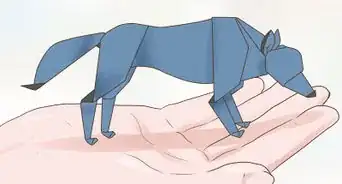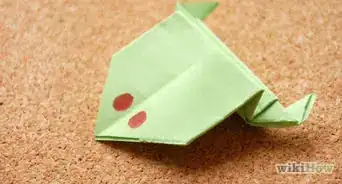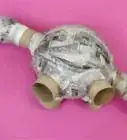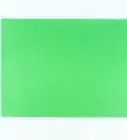wikiHow is a “wiki,” similar to Wikipedia, which means that many of our articles are co-written by multiple authors. To create this article, 18 people, some anonymous, worked to edit and improve it over time.
This article has been viewed 326,184 times.
Learn more...
Dinosaur enthusiasts who are good with their hands can express their love for these prehistoric beasts through the art of origami. There are various paper models to choose from, but it is best to opt for one based on your origami experience and skill level.
Steps
Beginner's Pureland T-Rex[1]
-
1Crease the paper in half. Position a sheet of square origami paper directly in front of you so that it looks like a diamond, with one corner at the top and one at the bottom. Fold the right corner over to meet the left corner. Crease well, then unfold.
- You can find a range of origami paper on Amazon.
- When you start, the outside of the paper should face you.
- Note that "pureland" refers to a type of origami that only uses basic mountain and valley folds.
-
2Valley fold to the center crease. Fold the top right edge of the paper in until it meets the crease at the center of the paper. Fold the top left edge in the same way so that it meets at the center crease.
- Note that a "valley fold" refers to a type of origami fold in which you fold the edge in your hand in, toward you, rather than folding it out and away from you.
Advertisement -
3Pre-crease along the angle bisector. Valley fold the lower left side up and in until the edge of this side meets the bottom edge of your previously folded top portions. Crease well, then unfold.
- For this step, you should only crease the center of this fold and not the entire length. The center of your creased portion should intersect with the first pre-crease you created in an earlier step.
- When done, turn the paper over so that the inside side faces you.
-
4Valley fold the top down. Bring the top tip down until it meets the point at which your two pre-creases intersect.
- When done, flip the paper over so that the original side shows again.
-
5Fold out the corners. You should see what appears to be a large triangle on the bottom and two quadrilaterals on the top. Take the inside bottom corner of each quadrilateral portion and valley fold it outward as far as the paper will allow you to fold before tearing.
- Turn the paper over to the other side again.
-
6Raise the top flap. You should be able to distinguish a downward pointing center triangle. Take the tip of this triangle and fold it up, straightening it out.
- You will be left with what looks like a diamond with tall upper half and a short lower half.
-
7Valley fold the bottom tip. Fold the lowest corner of the center diamond up so that it meets somewhere along the center of the upper tip, but not quite at the very top.
- More precisely, look at the rectangular portion lying behind the diamond shape. This section needs to be folded in half as you fold up the bottom tip.
- When done, turn the paper over again.
-
8Fold the inner flaps outward. You should notice two triangular flaps meeting at the center of paper. Fold these flaps outward as far as possible while still remaining flat and without tearing them.
-
9Swing down the back flap. Feel the back of the paper. There should be a flap along the back that is loose enough to move without affecting the rest of the structure. Unfold this flap and bring it straight down.
- When done, turn the paper back over.
-
10Add dimension. Pleat the top of the shape, positioning the pleating so that the mountain fold hits the crease separating the tip of the structure from the main part of the rectangular body. Valley fold the diagonal bottom sides in as far as they will go without ripping.
- A mountain fold refers to a fold made in which you fold the edges outward, creating a "mountain" peak facing you.
- When you pleat in origami, you use both a valley fold and a mountain fold. Make the valley fold to the inside of the intended mountain fold. Then, mountain fold the edge back along the instructed point.
- When done, turn the paper over.
-
11Pleat the bottom. Valley fold along the bottom-most crease you can find. Mountain fold a narrow strip just above this valley fold to complete the pleat.
-
12Make two more mountain folds. The first mountain fold should be at the very tip of the paper. For the second, mountain fold the model in half lengthwise.
-
13Valley fold the head. There is no set position for the head, so use your eye to determine what might look best. The head lies at the top tip right now. As a general rule, do not fold the head so far that it overlaps any of the legs or body.
- Rotate the model until the largest triangle, which forms the tail, can rest on the table.
- This step completes your origami T-Rex.
Intermediate Pterosaur
-
1Pre-crease the paper. Take a square sheet of origami paper and valley fold it in half horizontally. Crease well, then unfold. Valley fold in half vertically, crease well, and unfold.
- A valley fold is a type of origami fold in which the edge you work with is folded inward toward you, creating a "valley" or depression along the fold.
- At the completion of this step, rotate the paper by 45 degrees. It should now be in a diamond position, with one corner at the top and another at the bottom.
-
2Valley fold the bottom corner. Bring the bottom tip up so that it meets the center of the paper, marked by the intersection of your previous creases.
- When done, turn the model over to its other side.
-
3Make another pre-crease. Valley fold the bottom edge of your model up so that the crease falls along the imaginary line connecting the left and right corners of the paper model. Crease well, then unfold.
-
4Create a horizontal valley fold on the front-most layer. Mentally divide the bottom half of your model in half again. Valley fold the bottom edge up and inward, dividing this section in half. Only grab the front layer, though, and leave the back alone.
- Note that your bottom edge will meet the pre-crease made immediately prior to this.
-
5Pre-crease the model in half. Make a vertical valley fold along the vertical center of the model. Crease well, then unfold.
-
6Apply two more pre-creases. Look at the model in front of you. There should be a distinguishable upper triangle portion. Valley fold the upper right edge of this triangle down so that the bottom right corner of the triangular section is folded into two equal angles. Crease well, then unfold.
- For your second pre-crease, repeat this same procedure with the left side of the triangular section.
-
7Pre-crease the tip twice. Look at the upper tip of the model. It should be visually marked in half by your vertical center pre-crease. Valley fold each half of this top tip so that the resulting angles are equal in size. Crease well, then unfold.
- Note that the bottom edge of each crease in this step should stop at the lowest visible diagonal pre-crease made previously.
-
8Give the model dimension. You will need to make a series of valley and mountain folds along your pre-creases to add dimension to the model. These folds should be used to crease the paper model permanently, but do not fold the edges flat. Also note that a mountain fold is the opposite of a valley fold: fold the edges outward, creating a mountain-like peak along the fold itself.
- Note the distinguishable downward pointing triangle at the bottom of the model. Valley fold this piece in half vertically.
- Mountain fold the top part of the model in half vertically.
- Valley fold the top two diagonal pre-creases and the bottom two diagonal creases.
- Example the remaining pre-creases, which were made from your first set of pre-creases. Valley fold the inner portion of both creases, stopping when you hit other creases. Mountain fold the rest of these two pre-creases.
- When done, turn the model over.
-
9Valley fold the top. Bring the top-most tip of the model down, folding it so that the crease connects the inner corners just below this tip.
- At this point, you should compress the model by taking the triangular side flaps and pinching them in.
- Rotate the model by 90 degrees before continuing further.
-
10Make an inside reverse fold. Note the flap of paper sticking out to the right side of your model. Mountain fold along the lower left corner of this flap, separating the angle into equal portions.
- Note that the true lower corner of this flap lies beneath the visible surface of the model. You will need to use this corner and not the visible corner when folding.
-
11Make a similar outside reverse fold. While working with the same flap as in the previous step, note the bottom outside corner of the newly created triangular portion. Valley fold at this corner, effectively separating this angle into equal parts.
- When done, rotate the model by 90 degrees.
-
12Valley fold the upper portion. Disregarding the folded flap hanging off the top left side of the model, look at the main body of the model, including the flap hanging off the right. Create an imaginary line between the right-most corner and the left-most corner. Valley fold along this line.
- Turn the model over to its other side when done.
-
13Valley fold the model in half horizontally. You should be able to distinguish a clear tip on the left side of the model. Fold the model horizontally, dividing this tip in two equal halves.
- When done, rotate the model by another 90 degrees. You should be able to distinguish two clear wing portions and a body portion. Spread the wings apart by gently pushing them down and away from the body.
-
14Press in the lower tip of the body. Along the body section, you should see what looks like a "W" pattern of folds along the top and a single peak at the bottom. Gently press this bottom peak in, creating a blunt edge at the top of model.
- Note that the newly created flat region should look triangular in shape.
- Turn the model over when done.
-
15Apply a series of straight folds to the model. Note the two loose sections at the top of the wings. Make a mountain fold along the lower outside corner of each section, then unfold the main fold previously keeping the wings together.
-
16Make curved folds along the model. Look at the bottom two semi-triangular sections of the body. Make a gently curving valley fold connecting the bottom tips of these sections to the outside each section's own upper outside corner.
- After this, you will need to make another more dramatic set of curved valley folds. These folds should connect the outer-most corners of either wing to the innermost bottom corners of each wing. The curve should go inward at a gently angle.
- After making your curves, tuck the lower flaps produced by those folds into the upper flaps lying underneath.
- Turn the model over when done and rotate it by 90 degrees.
-
17Work on the head. Gently pull the head down, bending it along its natural crease.
- The head should be on the right side of the model.
- When done, rotate the model again by another 90 degrees.
-
18Define the head further. Make a mountain fold to the right of the hanging head flap and another one connecting the bottom of this fold to the body. Create a valley fold splitting the resulting intersection of your two mountain folds in half.
- The head should be on the right during this step.
- Turn the model over when done. Repeat this same procedure on the head from the other side, and rotate the model until the wings are spread out flat in front of you and the head faces toward the top.
-
19Valley fold the head. You should be able to note a natural crease near the head section of the model. Valley fold along this crease.
- This step completes the model. Examine it from all sides and redefine any creases that appear loose, if desired, to strengthen the overall shape.
Community Q&A
-
QuestionOn the second dinosaur, how do I do the first step?
 Community AnswerYou just need to take the top side and bring it down to the bottom line, then crease. Then do the same with the right side. Look at the video above if you still don't get it.
Community AnswerYou just need to take the top side and bring it down to the bottom line, then crease. Then do the same with the right side. Look at the video above if you still don't get it. -
QuestionWhat type of paper do I need?
 Community AnswerUse origami paper, which is square and thin. You can take computer paper and cut it into squares.
Community AnswerUse origami paper, which is square and thin. You can take computer paper and cut it into squares. -
QuestionCan we use different paper other than origami paper?
 Community AnswerYes, you can use any paper that is easy to handle (printer paper, construction paper, etc.). But make sure that the paper is a square and has equal sides (unless the project calls for a different shape).
Community AnswerYes, you can use any paper that is easy to handle (printer paper, construction paper, etc.). But make sure that the paper is a square and has equal sides (unless the project calls for a different shape).
Things You'll Need
About This Article
With a little patience and a sheet of origami paper, you can craft your own origami dinosaur. To make a T-Rex, position a sheet of square paper in front of you so it looks like a diamond. Fold the right corner over to meet the left corner. Crease it well and unfold it. Next, fold the top-right edge of the paper until it meets the crease at the center of the paper. Fold the top-left edge in the same way. Next, pre-crease along the angle bisector and valley fold the top down. Once you have a large triangle on the bottom and 2 quadrilaterals on the top, you can fold out the corners. Raise the top flap and valley fold the bottom tip. Then, fold the inner flaps outward. Swing down the back flap and add dimension by pleating the top and bottom of the shape. Make 2 more mountain folds, then valley fold the head. To learn how to make an intermediate origami pterosaur, keep reading!















































